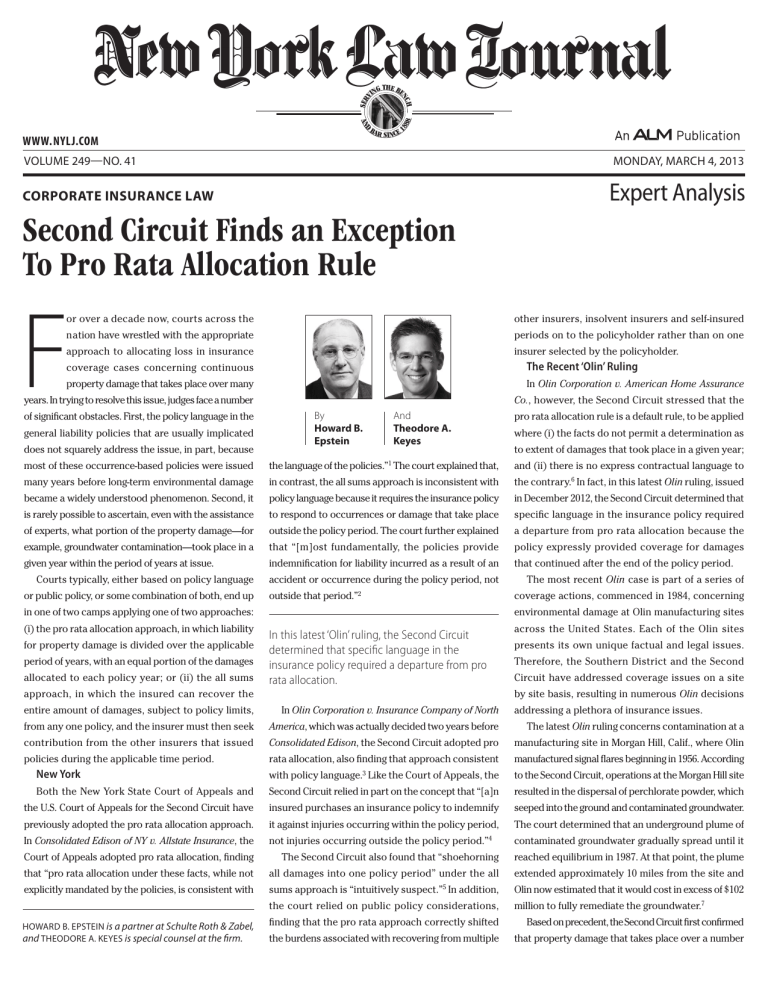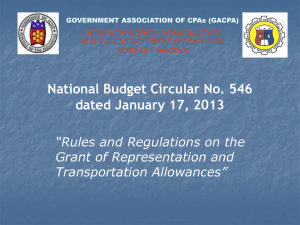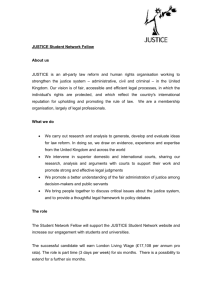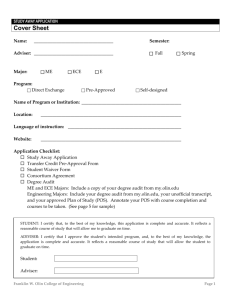
AND
88
8
SER
V
H
NC
THE BE
ING
1
BA
R SINCE
WWW. NYLJ.COM
MONDAY, MARCH 4, 2013
VOLUME 249—NO. 41
Expert Analysis
CORPORATE INSURANCE LAW
Second Circuit Finds an Exception
To Pro Rata Allocation Rule
F
or over a decade now, courts across the
other insurers, insolvent insurers and self-insured
nation have wrestled with the appropriate
periods on to the policyholder rather than on one
approach to allocating loss in insurance
insurer selected by the policyholder.
The Recent ‘Olin’ Ruling
coverage cases concerning continuous
property damage that takes place over many
In Olin Corporation v. American Home Assurance
years. In trying to resolve this issue, judges face a number
Co., however, the Second Circuit stressed that the
of significant obstacles. First, the policy language in the
general liability policies that are usually implicated
does not squarely address the issue, in part, because
By
Howard B.
Epstein
And
Theodore A.
Keyes
pro rata allocation rule is a default rule, to be applied
where (i) the facts do not permit a determination as
to extent of damages that took place in a given year;
most of these occurrence-based policies were issued
the language of the policies.”1 The court explained that,
and (ii) there is no express contractual language to
many years before long-term environmental damage
in contrast, the all sums approach is inconsistent with
the contrary.6 In fact, in this latest Olin ruling, issued
became a widely understood phenomenon. Second, it
policy language because it requires the insurance policy
in December 2012, the Second Circuit determined that
is rarely possible to ascertain, even with the assistance
to respond to occurrences or damage that take place
specific language in the insurance policy required
of experts, what portion of the property damage—for
outside the policy period. The court further explained
a departure from pro rata allocation because the
example, groundwater contamination—took place in a
that “[m]ost fundamentally, the policies provide
policy expressly provided coverage for damages
given year within the period of years at issue.
indemnification for liability incurred as a result of an
that continued after the end of the policy period.
Courts typically, either based on policy language
or public policy, or some combination of both, end up
accident or occurrence during the policy period, not
outside that period.”2
in one of two camps applying one of two approaches:
(i) the pro rata allocation approach, in which liability
for property damage is divided over the applicable
period of years, with an equal portion of the damages
allocated to each policy year; or (ii) the all sums
The most recent Olin case is part of a series of
coverage actions, commenced in 1984, concerning
environmental damage at Olin manufacturing sites
In this latest ‘Olin’ ruling, the Second Circuit
determined that specific language in the
insurance policy required a departure from pro
rata allocation.
across the United States. Each of the Olin sites
presents its own unique factual and legal issues.
Therefore, the Southern District and the Second
Circuit have addressed coverage issues on a site
by site basis, resulting in numerous Olin decisions
approach, in which the insured can recover the
entire amount of damages, subject to policy limits,
In Olin Corporation v. Insurance Company of North
from any one policy, and the insurer must then seek
America, which was actually decided two years before
The latest Olin ruling concerns contamination at a
contribution from the other insurers that issued
Consolidated Edison, the Second Circuit adopted pro
manufacturing site in Morgan Hill, Calif., where Olin
policies during the applicable time period.
addressing a plethora of insurance issues.
rata allocation, also finding that approach consistent
manufactured signal flares beginning in 1956. According
New York
with policy language.3 Like the Court of Appeals, the
to the Second Circuit, operations at the Morgan Hill site
Both the New York State Court of Appeals and
Second Circuit relied in part on the concept that “[a]n
resulted in the dispersal of perchlorate powder, which
the U.S. Court of Appeals for the Second Circuit have
insured purchases an insurance policy to indemnify
seeped into the ground and contaminated groundwater.
previously adopted the pro rata allocation approach.
it against injuries occurring within the policy period,
The court determined that an underground plume of
In Consolidated Edison of NY v. Allstate Insurance, the
not injuries occurring outside the policy period.”4
contaminated groundwater gradually spread until it
Court of Appeals adopted pro rata allocation, finding
The Second Circuit also found that “shoehorning
reached equilibrium in 1987. At that point, the plume
that “pro rata allocation under these facts, while not
all damages into one policy period” under the all
extended approximately 10 miles from the site and
explicitly mandated by the policies, is consistent with
HOWARD B. EPSTEIN is a partner at Schulte Roth & Zabel,
and THEODORE A. KEYES is special counsel at the firm.
5
sums approach is “intuitively suspect.” In addition,
Olin now estimated that it would cost in excess of $102
the court relied on public policy considerations,
million to fully remediate the groundwater.7
finding that the pro rata approach correctly shifted
Based on precedent, the Second Circuit first confirmed
the burdens associated with recovering from multiple
that property damage that takes place over a number
MONDAY, MARCH 4, 2013
of policy periods will be allocated over the time during
though the American Home policy expired in 1972, the
which the property damage occurred. In this case, the
court vacated the Southern District ruling and held that
Although courts in other states continue to wrestle
court determined that property damage took place from
American Home was liable for property damage that
with the appropriate allocation method for progressive
1956-1987, and therefore that liability would be allocated
occurred during the policy period as well as any property
property damage cases, it appears that the majority
to the policies issued during that 31-year period.
damage that continued during the period from 1972
of courts (but certainly not all courts) that have
Looking Forward
Next, the court reiterated that, “in the absence of
through 1987. The court also concluded that property
addressed the issue have adopted pro rata allocation,
contractual provisions to the contrary or evidence
damage from the migration of chemicals in an expanding
including relatively recent decisions issued by the
indicating that ascertainable amounts of damage
groundwater plume falls within the scope of continuing
highest courts in Massachusetts and Vermont.10 The
occurred in certain years,” the damage would be
damage contemplated by Condition C.
recent Olin decision by the Second Circuit does not
allocated on a pro rata basis. If that were the courts’
American Home protested the court’s interpretation
alter New York’s pro rata allocation rule, but it does
final determination, in accordance with such a pro
of Condition C on the grounds that the result would
make clear that the federal courts, at least, view this as
rata allocation, the court would have divided the $102
be contrary to the pro rata allocation rule adopted by
a default rule and that courts should review the policy
million in damages by 31 and allocated approximately
the Second Circuit. The court rejected this argument,
language at issue to make sure the default rule applies.
$3.3 million to each policy year. However, while the
explaining that the prior pro rata allocation rulings
In Olin, the presence of express language mandating
court found no factual basis to calculate the amount
“simply provide that when insurance contracts do
coverage for property damage that continued beyond
of groundwater contamination that occurred in any
not adequately define how progressive environmental
the policy period justified an exception to the pro rata
given year, it did identify a policy clause that required
damage is to be apportioned across multiple triggered
allocation rule. However, one would expect that, in most
a departure from pro rata allocation.
policies, and the evidence cannot make that distinction,
cases, where policies only cover damage that takes
Condition C
New York law requires damage to be allocated pro
place during the policy period, the pro rata allocation
The dispute before the Second Circuit in Olin
rata.”9 The court further explained that the general
rule will be routinely applied.
concerned the coverage obligations of American
pro rata allocation rule does not preclude the insurer
While in Olin, the Second Circuit found an exception
Home, an excess insurer that issued policies to Olin
from including policy terms that specifically address
to pro rata allocation based on unique policy language, it
which followed form to underlying excess policies
the issue by providing indemnification for damages
remains possible that an exception could also be justified
issued by Underwriters at Lloyd’s London. American
allocated to the years after termination of the policy.
in a case where the evidence presents a factual basis to
Home had issued two excess policies, one covered
the period from 1966-1969 and one covered the period
from 1969-1972. Each of the American Home policies
provided coverage for up to 10 percent of $10 million
excess of $30.3 million in underlying limits.
The Southern District had granted summary
judgment to American Home on the grounds that
damages, allocated on a pro rata basis, would not exceed
allocate damages. For example, the U.S. District Court for
The ‘Olin’ decision by the Second Circuit does not
alter New York’s pro rata allocation rule, but it does
make clear that the federal courts, at least, view
this as a default rule and that courts should review
the policy language at issue to make sure the
default rule applies.
the District of Massachusetts recently issued a ruling in
which it determined that the default pro rata allocation
rule did not apply, because expert testimony provided
a basis to calculate the amount of soil contamination
that occurred during the applicable policy periods.11
Thus, instead of a pro rata allocation, the court assigned
to the insurer the damages incurred to remediate the
the underlying limits. Olin appealed the ruling to the
The Second Circuit also resisted American Home’s
volume of soil contamination that occurred during the
Second Circuit. On appeal, the Second Circuit focused on
invitation to follow the lead of courts in all-sums
years in which the insurer had issued policies. Given
Condition C of the policies, which provided as follows:
jurisdictions, many of whom have simply rejected certain
the recent decision in Olin, a New York court presented
Prior Insurance and Non-Cumulation of Liability
policy clauses, like non-cumulation clauses, on the grounds
with sufficient scientific evidence to determine the actual
It is agreed that if any loss covered hereunder is also
that such clauses contradict the forum’s chosen allocation
damages that occurred during a given policy year may
covered in whole or in part under any other excess
method. Further, the Second Circuit rejected any suggestion
similarly find an exception to the pro rata allocation rule.
policy issued to the Assured prior to the inception
that Condition C mandated an all-sums type approach.
date hereof, the limit of liability hereon…shall be
Instead, the Second Circuit indicated that damages
reduced by any amounts due to the Assured on
would be allocated over the 31-year period, but that
account of such loss under such prior insurance.
subject to policy limits, pursuant to Condition C, American
Subject to the foregoing paragraph and to all the
Home would be responsible for the damages allocated
other terms and conditions of this Policy, in the event
to the period from 1966-1987. The court did not address
that personal injury or property damage arising out of
whether or how policies issued to Olin by other insurers
an occurrence covered hereunder is continuing at the
during those same years would share in the liability.
time of termination of this Policy, Underwriters will
Fortunately for American Home, having enforced
continue to protect the Assured for Liability in respect
clause two of Condition C, the Second Circuit also
of such personal injury or property damage without
enforced the non-cumulation provision in clause one
8
payment of additional premium. [emphasis added]
of Condition C. The court found that clause one confined
The Second Circuit held that the second clause in
American Home’s liability to the $1 million policy limit of
Condition C expressly imposed liability on American
the policy issued for the period from 1969-1972, since the
Home for covered property damage that continued
amount recoverable under the second policy would be
beyond the expiration of the policy. Therefore, even
reduced by any amount recovered under the first policy.
•••••••••••••
••••••••••••••••
1. Consolidated Edison of N.Y. v. Allstate Ins., 98 N.Y.2d 208,
224, 774 N.E.2d 687 (2002).
2. Id. at 224.
3. Olin Corporation v. Insurance Company of North America,
221 F.3d 307 (2d Cir. 2000).
4. Id. at 322.
5. Id. at 322-323.
6. Olin Corporation v. American Home Assurance, 704 F.3d
89 (2d Cir. 2012).
7. Id.
8. Id.
9. Id.
10. Boston Gas v. Century Indemnity, 454 Mass. 337, 910
N.E.2d 290 (Mass. 2009); Bradford Oil v. Stonington Insurance,
190 Vt. 330, 54 A.3d 983 (Vt. 2011).
11. Peabody Essex Museum. v. U.S. Fire Insurance, No.
06cv11209, 2012 WL 2952770 (D. Mass. July 8, 2012).
Reprinted with permission from the March 4, 2013 edition
of the NEW YORK LAW JOURNAL © 2013 ALM Media
Properties, LLC. All rights reserved. Further duplication without
permission is prohibited. For information, contact 877-257-3382
or reprints@alm.com. # 070-03-13-30






